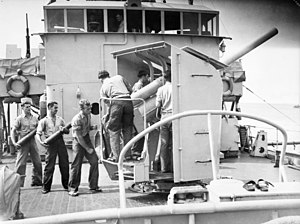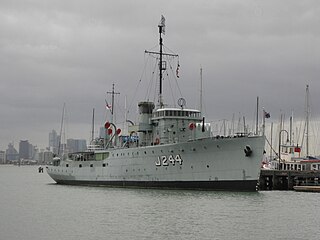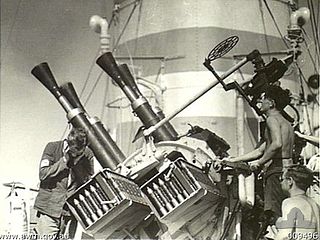
The 2-pounder gun, officially designated the QF 2-pounder and universally known as the pom-pom, was a 40-millimetre (1.6 in) British autocannon, used as an anti-aircraft gun by the Royal Navy. The name came from the sound that the original models make when firing. This QF 2-pounder was not the same gun as the Ordnance QF 2 pounder, used by the British Army as an anti-tank gun and a tank gun, although they both fired 2 pounds (0.91 kg), 40 millimetres (1.6 in) projectiles.

The BL 16-inch Mark I was a British naval gun introduced in the 1920s and used on the two Nelson-class battleships. A breech-loading gun, the barrel was 45 calibres long meaning 45 times the bore (16 in) – 60 ft (18 m) long.
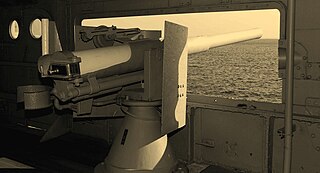
The QF 12-pounder 12-cwt gun was a common, versatile 3-inch (76.2 mm) calibre naval gun introduced in 1894 and used until the middle of the 20th century. It was produced by Armstrong Whitworth, Elswick and used on Royal Navy warships, exported to allied countries, and used for land service. In British service "12-pounder" was the rounded value of the projectile weight, and "12 cwt (hundredweight)" was the weight of the barrel and breech, to differentiate it from other "12-pounder" guns.

The Ordnance QF Hotchkiss 6 pounder gun Mk I and Mk II or QF 6 pounder 8 cwt were a family of long-lived light 57 mm naval guns introduced in 1885 to defend against new, small and fast vessels such as torpedo boats and later submarines. There were many variants produced, often under license which ranged in length from 40 to 58 calibers, but 40 caliber was the most common version.

The 4"/50 caliber gun was the standard low-angle, quick-firing gun for United States, first appearing on the monitor Arkansas and then used on "Flush Deck" destroyers through World War I and the 1920s. It was also the standard deck gun on S-class submarines, and was used to rearm numerous submarines built with 3-inch (76 mm) guns early in World War II. United States naval gun terminology indicates the gun fired a projectile 4-inch (102 mm) in diameter, and the barrel was 50 calibers long.

The QF 4 inch Mk V gun was a Royal Navy gun of World War I which was adapted on HA mountings to the heavy anti-aircraft role both at sea and on land, and was also used as a coast defence gun.

The QF 4 inch Mk XVI gun was the standard British Commonwealth naval anti-aircraft and dual-purpose gun of World War II.

The BL 6-inch gun Marks II, III, IV and VI were the second and subsequent generations of British 6-inch rifled breechloading naval guns, designed by the Royal Gun Factory in the 1880s following the first 6-inch breechloader, the relatively unsuccessful BL 6-inch 80-pounder gun designed by Elswick Ordnance. They were originally designed to use the old gunpowder propellants but from the mid-1890s onwards were adapted to use the new cordite propellant. They were superseded on new warships by the QF 6-inch gun from 1891.

The QF 4-inch gun Mk IV was the main gun on most Royal Navy and British Empire destroyers in World War I. It was introduced in 1911 as a faster-loading light gun successor to the BL 4 inch Mk VIII gun. Of the 1,141 produced, 939 were still available in 1939. Mk XII and Mk XXII variants armed many British interwar and World War II submarines.

The BL 4-inch gun Mk VII was a British high-velocity naval gun introduced in 1908 as an anti-torpedo boat gun in large ships, and in the main armament of smaller ships. Of the 600 produced, 482 were still available in 1939 for use as coastal artillery and as a defensive weapon on Defensively Equipped Merchant Ships (DEMS) during the Second World War.

The BL 4-inch Mark VIII naval gun was a British medium-velocity wire-wound naval gun introduced in 1908 as an anti-torpedo boat gun in smaller ships whose decks could not support the strain of the heavier and more powerful Mk VII gun.

The BL 4-inch Mk IX naval gun was a British medium-velocity naval gun introduced in 1916 as secondary armament on the Renown-class battlecruisers and Glorious-class "large light cruisers", but which served most notably as the main armament on Flower-class corvettes throughout World War II.

The BL 4.7-inch, 45-calibre gun was a British medium-velocity naval gun introduced in 1918 for destroyers, intended to counter a new generation of heavily armed destroyers that Germany was believed to be developing.
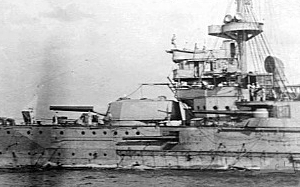
The EOC 10-inch 45 calibre gun were various similar 10-inch naval guns designed and manufactured by Elswick Ordnance Company to equip ships they built and/or armed for several countries before World War I.

The QF 4.7 inch Gun Mark V originated as a 4.7 in (120 mm) 45-calibre naval gun designed by the Elswick Ordnance Company for export customers and known as the Pattern Y.

The 6"/53 caliber gun formed the main battery of some United States Navy light cruisers and three US submarines built during the 1920s.

The 4.7 inch QF Mark IX and Mark XII were 45-calibre, 4.7-inch (120 mm) naval guns which armed the majority of Royal Navy and Commonwealth destroyers in World War II, and were exported to many countries after World War II as the destroyers they were mounted on were sold off.

The QF 4.7 inch Gun Mark VIII was a British naval anti-aircraft gun designed in the 1920s for the Royal Navy. This was the largest caliber fixed ammunition gun ever in service in the RN, though the round was considerably shorter and lighter than the round for the QF 4.5-inch Mk I – V naval gun. It was carried in powered HA XII mountings on the two Nelson-class battleships, two of the three Courageous-class aircraft carriers, the minelayer HMS Adventure, and the Australian seaplane tender HMAS Albatross.

The 4.7 inch QF Mark XI was a 50-calibre, 4.7-inch (120 mm) naval gun deployed on Royal Navy (RN) and Allied destroyers during World War II.

The BL 6-inch Mk XXII gun was a British high-velocity 6-inch 50-calibre wire-wound naval guns deployed on the Nelson-class battleships from the 1920s to 1945.
